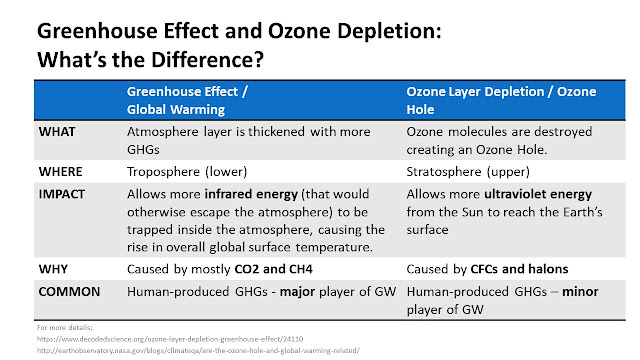 |
| Source: joaquincorbalan/elements.envato.com |
Why is the ozone layer depleted, and why is that a problem? How does it differ from the greenhouse effect? Is the ozone hole still there?
Also, read the following:
Global-Scale Pollution (Part 2): How Does Global Warming Occur?
Global-Scale Pollution (Part 3): How Does Global Warming Affect the Environment and Human Equality?
Why does ozone layer depletion occur?
Ozone layer depletion or ozone hole is a stratosphere story because it occurs in the stratosphere layer of the environment, which is between 10-50km from the Earth's surface. On the ground level, ozone is a pollutant that causes smog. However, we need the ozone layer in the stratosphere because it is critical in protecting our life.
The problem is that this stratosphere ozone is increasingly being destroyed, creating an ozone hole. Technically, it is not a "hole" without any ozone but is a region in the stratosphere of significantly depleted ozone. Little ozone remains because the ozone molecules there have been destroyed by chlorine and bromine gases from man-made pollutants called chlorofluorocarbons (CFCs) and halon. The polar ozone hole has grown more significant yearly since its discovery in the 1970s.
Why is it a problem?
The ozone layer provides a protective shield absorbing some potentially harmful ultraviolet (UV) radiation from the sun before reaching Earth. Ozone layer depletion causes increased UV radiation levels at the Earth's surface.
Why is that a problem? Because excessive UV can damage human health. Adverse effects include increases in certain skin cancers, eye cataracts and immune deficiency disorders. The effects are most profound in Australia, New Zealand and South America, regions closer to Antarctica at the south pole.
Isn't global warming the same thing?
No. The table below summarises the difference between the two phenomena. Generally, the greenhouse effect or global warming occurs because the atmosphere layer is thickened with more greenhouse gases (GHGs). That allows more infrared energy or heat to be trapped inside the atmosphere, causing global surface temperature to rise.
On the other hand, the ozone layer protects us from UV energy from the sun. Ozone layer depletion means the ozone molecules are destroyed, creating an ozone hole. This hole allows more UV energy from the sun to reach the Earth's surface.
The greenhouse effect is mainly caused by GHGs like carbon dioxide (CO2) and methane (CH4), whereas ozone-layer depletion is caused by ozone-depleting substances (ODS) such as CFCs and halons. What these gasses have in common is that they are human-produced GHGs; hence, they are considered heat-trapping pollutants.
The difference is that CFCs are present in small atmospheric concentrations (several hundred parts per trillion) and are considered minor global warming players. Comparatively, CO2 is present in a vast atmospheric concentration (several hundred parts per million) and is regarded as a major global warming player. Although CH4 emissions comprise 10% of GHG (compared to 81% of CO2 based on 2016 data), it is more potent in causing global warming than CO2.
Positively speaking, CFCs are now being replaced by HFCs (hydrofluorocarbons) because HFCs emissions do not deplete the ozone layer. However, HFCs can trap the heat in the atmosphere, contributing to global warming.
Is the hole still there?
Today, the ozone hole in Antarctica is gradually healing and is expected to return to 1980 levels between 2050 and 2070.
How is that so?
The world has phased out 98% of ODS globally compared to 1990 levels, thanks to the full and sustained implementation of the Montreal Protocol since 1987. The Protocol is one of the most successful environmental agreements of all time. It gradually phases down the consumption and production of the different ODS, with varying schedules for developed and developing countries.
Without this treaty, the ozone hole would have increased tenfold by 2050 compared to current levels, resulting in millions of extra cases of melanoma, other cancers and eye cataracts. It has been estimated, for example, that the Montreal Protocol is saving about 2 million people each year by 2030 from skin cancer. This remarkable success story remains an inspiring example of what international cooperation can achieve.




Comments
Post a Comment